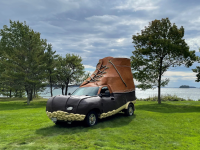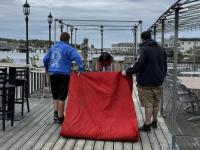Escape from terror
As we listen to the elderly World War II veterans tell of battles won and sacrifices made, we sometimes forget there were thousands of ordinary folks caught in the middle of that epic struggle. These were the folks, then officially called displaced persons, who fled their homes in a desperate effort to survive.
Today, in the Mideast and Europe, you can see the faces of a similar tide of migrants fleeing the Syrian civil war.
While we understand why these folks left their homes (war is dangerous, after all), but how do they survive as they walk along strange roads into an unknown future?
More than 70 years ago, one of our neighbors, Paul Bokros, a longtime Barters Island summer resident, was one of thousands of refugees caught in the wake of the Nazi conquest of Europe.
Today, you see him as a kindly 87-year-old gentleman, with thick glasses, an even thicker accent, and a wide and welcoming smile.
“How can you not smile. We are in Boothbay,” he said as we met the other day at the Boothbay Harbor Memorial Library.
I wanted to hear his story, an epic journey that took him from the terrors of Nazi-occupied Belgrade in the former Yugoslavia to the quiet shores of our scenic peninsula.
He began by explaining that his father had a successful import-export business until the Nazis came. As danger lurked outside their home, with the help of anti-Nazi Yugoslav partisans, his father, his mother and three children fled Belgrade. They escaped to Split on the Dalmatian coast where they were smuggled across the Adriatic Sea into southern Italy.
It was 1944. As Allied armies pushed the Nazis out of Italy, thousands of refugees were left in their wake. Like others fleeing war, the Bokros family bounced around. At one point they came under the protection of the British Army, wearing cast off British uniforms and eating when they could.
About the time the American Army liberated Rome, his father came home and told the family they might be able to go to America. They were thrilled, even though the first leg of their journey meant they were housed in an abandoned insane asylum.
For Bokros and his friends, it was just another adventure.
“I was with a group of boys, 14-15 years old, and we loved it. It was a great place to explore. We went into one room that had dozens of human brains in glass jars. We thought it was pretty neat,” he said.
Although Bokros did not know it at the time, despite well-documented Nazi atrocities, there was a great reluctance on the part of much of the nation, in Congress and the State Department, to permit Europeans, especially Jewish refugees, to escape to America.
It was only though the intervention of President Franklin D. Roosevelt that a group of 1,000 refugees from Italy, including the Bokros family, were permitted to come to America.
“We were taken to Naples and brought to a huge boat,” he said.
It was an Army troop transport ship, the USNS Henry Gibbins, a 500-foot-long vessel designed to carry 2,000 soldiers.
The Bokros family claimed a little area of the bow section of the ship for themselves, as did the rest of the nearly 1,000 refugees. The aft section was filled with wounded American soldiers going home.
After settling into their new quarters, they were ushered to the mess deck where they were astonished.
“We had been living on one or maybe two meals a day and we were happy when we had one (meal) a day. There on the mess deck counter we saw a line of food we didn't know existed in the world. There were eggs and pancakes and ...,” he said.
The transport was part of a huge convoy that sailed into the Mediterranean Sea flanked by two boats carrying German prisoners of war to protect the wounded GIs and refugees from U-boat attacks.
At one point the ship stopped when they were spotted by German planes. They were ordered below decks as the vessel was hid under a blanket of artificial fog for what seemed to be hours.
The slow moving convoy, escorted by American warships, passed through the Straits of Gibraltar into the Atlantic. One day Bokros looked over the bow and saw the New York City skyline and the Statue of Liberty.
It has been more than 70 years since the teenage refugee spotted Lady Liberty presiding over New York harbor, but that vivid memory still triggers a deep emotional response from the elderly grandfather.
Next week, we will continue his story.
Event Date
Address
United States


























